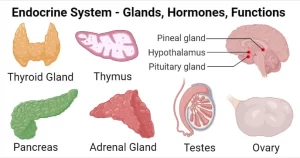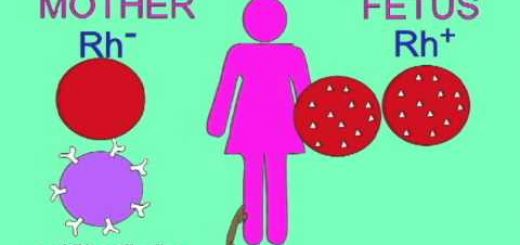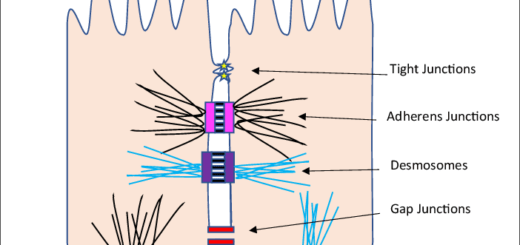Hormones in the human body, Function of Endocrine glands and Growth hormone disorder
Pituitary gland is called the master gland or the main gland because it secretes hormones that regulate the activities of most of other endocrine glands. The pituitary gland plays an important role in delivery and breast feeding processes because it secretes the facilitating hormone during delivery and the mammary glands activating hormone to activate the mammary glands to secrete milk during breast feeding process.
Hormones in the human body
The nervous system organizes and coordinates both the activities and functions of the organs of living organisms, But, scientists through their experiments and researches proved that there is another form of organizing and coordinating of these activities and functions, This form is performed by chemical substances secreted by special cells in the body, These secretions are known as Hormones.
The hormone is a chemical substance (or a chemical message) that controls and organizes most of the vital activities and functions in the bodies of living organisms. Hormones are secreted in the body by some organs called “Endocrine glands or Ductless glands. Endocrine glands are ductless glands that secrete their hormones directly into the blood without passing through ducts.
Blood is considered the only way for the hormones (which are secreted by endocrine glands) to reach their sites of action (target cells) because the cells (which are known as target cells) that the hormones affect are almost located away from the endocrine gland that secretes the hormone.
Hormones transfer from endocrine glands to the target cells through the blood, Target cells are the cells that the hormones affect and they have almost located away from the endocrine gland that secretes the hormone, The endocrine glands (ductless glands) are called by this name because they secrete their hormones directly in blood without passing through ducts.
Most important endocrine glands in the human body
- Pituitary gland.
- Thyroid gland.
- Two adrenal glands.
- Pancreas gland.
- Reproductive glands: In male (Two testes), In female (Two ovaries).
Endocrine glands secrete more than 50 hormones in the human body in limited quantities. On the occurrence of a disorder in the action of one of the endocrine glands, this affects the percentage of its secretion (by increasing or decreasing than the normal level) causing disease symptoms which are known as hormone disorder. Hormone disorder is the increase or decrease in the secretion of one of the hormones, when the endocrine gland that secretes it doesn’t act properly.
Pituitary gland
The pituitary gland is a small gland in the size of a pea seed, It consists of two lobes. It is located below the brain. It secretes hormones that regulate the activities of most of the other endocrine glands. So, it is called the “master gland” or the main gland”. Each lobe of the two lobes of the pituitary gland secretes a group of different hormones.
Some hormones of the pituitary gland
- Growth hormone.
- Facilitating hormone during delivery.
- Thyroid-stimulating hormone (TSH)
- Hormones regulating amount of water in the body.
- Adrenal glands activating hormone
- Sexual glands activating hormone (two testes and two ovaries) that regulates the growth and the development of sex organs.
- Mammary glands activating hormone to secrete milk during breastfeeding process.
Growth hormone
Growth hormone controls the speed of growth rate of body muscles, bones, and other organs. So, It determines the height that the person will reach when he becomes fully grown.
Some diseases resulted from the growth hormone disorder in the human body
Dwarfism
- Reason: Decrease in the secretion of the growth hormone in childhood.
- Feature of disorder: The body stops growing, so the person becomes a dwarf.
Gigantism
- Reason: Increase in the secretion of the growth hormone at childhood.
- Feature of disorder: A continuous growth in the limbs’ bones. so the person becomes a giant.
When the secretion of growth hormone is decreased in childhood, The body stops growing, so the person becomes a dwarf. When the secretion of growth hormone is increased in childhood, continuous growth in the limb’s bones occurs, so the person becomes giant.
The height of some persons may exceed 2 metres. The limb’s bones of some people grow continuously, so they become giants due to the increase in the secretion of the growth hormone at childhood. The height of some persons may reach less than half metre. so the person becomes a dwarf due to the decrease in the secretion of the growth hormone at childhood.
Thyroid gland
The thyroid gland consists of two lobes, linked together by a small part. It is located on the front surface of the neck on both sides of the trachea. It secretes two hormones which are:
- Thyroxin hormone plays the main role in food assimilation processes in the body. where it liberates the energy necessary for the human body from food.
- Calcitonin hormone controls the level of calcium in the blood.
The thyroid gland plays an important role in controlling the level of calcium in the blood because it secretes the calcitonin hormone which controls the level of calcium in the blood.
Some diseases resulted from the thyroxin hormone disorder in the human body
On the occurrence of a disorder in the secretion of the thyroxin hormone from the thyroid gland, this will lead to goiter disease which has 2 shapes as follows:
Simple goiter
- Reason: Decrease in the secretion of the thyroxin hormone due to the lack of iodine from food as it enters in the hormone’s structure.
- Symptoms of the disease: Enlargement of the thyroid gland and the neck.
Exophthalmic goiter
- Reason: Increase in the secretion of the thyroxin hormone in large amounts.
- Symptoms of the disease: Enlargement of thyroid gland accompanied by loss of weight, tension, and exophthalmoses.
Some persons have an enlarged thyroid gland due to a decrease or increase in the secretion of the thyroxin hormone. Man suffers from simple goiter disease when his food lacks iodine due to the decrease in the secretion of thyroxin hormone as a result of the lack of iodine from food because it enters in the hormone’s structure.
The food must contain iodine because iodine enters in the structure of the thyroxin hormone which plays a main role in food assimilation processes in the body. Iodine salt is preferred over normal salt because iodine salt is rich in iodine element that enters in the thyroxin hormone’s structure.
Two adrenal glands
Two adrenal glands are located adhering to the top of the kidney. They secrete the adrenalin hormone. Adrenalin hormone stimulates the body’s organs to respond to emergencies like fear, anger, and emotion.
When a man is exposed to fear and horror, The pituitary gland responds by secretion of adrenal glands activating hormone, so these adrenal glands secrete adrenalin hormone which stimulates the body’s organs to respond to emergencies.
Pancreas gland
The pancreas gland is located between the stomach and the small intestine. It secretes two hormones which are Insulin hormone and Glucagon hormone.
Insulin hormone
Insulin hormone reduces the level of glucose sugar in the blood. That’s occurred by stimulating:
- Body cells to use glucose as a source of energy.
- Liver cells to store excess glucose super in the body in the form of glycogen.
Glucagon hormone
Glucagon hormone raises the level of glucose sugar in the blood. That’s occurred by stimulating: Liver cells to convert the stored glycogen into glucose sugar that releases into the bloodstream to be available to body cells.
When the level of glucose sugar in the blood increases than the normal level, The pancreas gland will respond by secreting insulin hormone. When the level of glucose sugar in the blood decreases than the normal level, The pancreas gland will respond by secreting glucagon hormone.
Insulin hormone converts Glucose sugar in the blood into glycogen in the liver cells. Glucagon hormone converts Glyngen in the liver cells into Glucose sugar in the blood. The function of the glucagon hormone contradicts the function of the insulin hormone.
The pancreas is a mixed gland because the pancreas acts as a ductless gland that secretes the insulin and glucagon hormones directly to the blood (that regulate the glucose sugar level in the blood), and it also acts as a duct gland that secretes digestive juices to the pancreatic duct (that help in the digestion process).
Features of disorder in the secretion of insulin hormone
On the occurrence of a disorder in the secretion of insulin hormone from the pancreas gland. this will lead to the infection with diabetes disease. Diabetes is a disease caused by the decrease in the secretion of the insulin hormone, which leads to increasing of the level of glucose sugar in the blood and its existence in the urine.
- Reason: Decrease in the secretion of the insulin hormone which leads to the cells are unable to use glucose.
- Symptoms: Feeling very thirsty and multiple urination times.
Diabetes disease is treated with insulin hormone because it reduces the percentage of glucose sugar in the blood.
Reproductive glands
- Two testes glands: They secrete testosterone hormone. The testosterone hormone is responsible for the appearance of the male secondary sex characters.
- Two ovaries glands secrete Two hormones: Estrogen hormone is responsible for the appearance of the female secondary sex characters, and progesterone hormone promotes the growth of the endometrium (The lining of the uterus).
The female vocal cords produce voices louder than those produced by male one, This is because the sexual hormones in the mature male body cause an increase in the thickness of vocal cords, so the thin vocal cords in a female’s larynx vibrate faster than the thick vocal cords in the male’s larynx.
The pituitary gland in the body of dwarf persons secretes extremely small amounts of growth hormones, In the past, scientists treated these people by injecting them with human growth hormone extracted from the recently dead corpses of the children’s bodies, But, the amounts of growth hormone obtained by this method were extremely not enough in addition to the possibility of containing some microbes which may cause infection by various diseases.
In 1979, by Genetic engineering technology, scientists manufactured sufficient amounts of human growth hormone by inserting a human gene that carries instructions for information of human growth hormone into DNA nucleic acid of the bacterial cells.
In this way, they were able to produce and collect large amounts of the human growth hormone by great numbers of bacteria (in which this gene was inserted) then, this hormone was refined and tested. In 1985, the researches conducted on this hormone proved its validity for human use to treat children with limited growth.
Steps of synthesis of growth hormone by genetic engineering
- Separating DNA from the bacterial cell.
- Separating a human gene carries instructions for information of human growth hormone.
- Inserting the human gene into bacterial DNA.
- Introducing the DNA which carries the gene into the bacterial cell.
- Multiplication of growth hormone through the multiplication of bacterial cells.
- Separation and purification of the growth hormone.
- Using the growth hormone in the treatment of a dwarf person.
You can follow science online on YouTube from this link: Science online
You can download Science Online application on Google Play from this link: Science online Apps on Google Play
Pituitary gland function, structure, location, hormones and anatomy
Anterior pituitary gland function, hormones, location and Effects of Growth Hormone
Endocrine system structure, function, disorders, Endocrine Glands and Hormones types
Endocrine system, Endocrine glands, Pituitary gland & Hormonal coordination in living organisms
Posterior pituitary gland hormones and function, Control of ADH and Oxytocin hormone
Thyroid gland, Diseases of thyroid gland and Function of Parathyroid glands
Genes, Chromosomes, Proteins, Bacteriophages and Quantity of DNA in the cells




